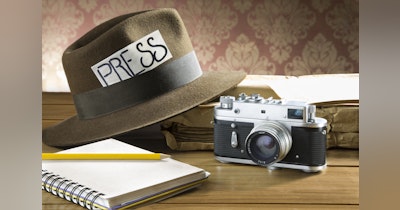Previously, we used this space to give you some tips for producing better remote broadcast interviews over Zoom, Skype, Cisco Webex, and other platforms. But if you want to look and sound your ultimate best when joining news shows live from your home or office, you might also consider a small investment in technology that can have a big impact on the quality of your video and audio.
Television news anchors and reporters use two pieces of equipment that are almost invisible to their viewers yet together they improve their presentations on the air – a lavalier microphone and a Telex earset.
The chances are good you’ve heard of a “lav” or “lapel” microphone. It’s likely you’ve worn them when visiting local television stations for on-set interviews, or when news crews show up at your office asking questions on video. They are preferred because they get the microphone close to your face without polluting the shot with a big clunky handheld mic.
It is less likely that you have worn a Telex earset, but it is possible you have seen them used by law enforcement personnel. News flash: Television anchors wear them too! They are essentially an invisible headset, a single earpiece made of clear plastic tubing that clips to the back of your collar, wraps around the back of your ear, and discreetly tucks inside it, allowing you to hear everything without the device being seen by audiences.
Both of these items, the lavalier microphone and the Telex earset, are available from numerous consumer electronics outlets at prices that make them a valuable and affordable investment if you find yourself doing a lot of live television interviews over the internet.
When coupled with an equally cheap and easy-to-use USB audio interface, required to connect the mic and earset to your computer, you can set up a broadcast-quality audio feed, while cleaning up your look for television viewers, for about $250.
You might be asking why you’d want to spend the money when your desktop or laptop computer comes with a built-in microphone and speakers. Since the pandemic forced everyone online, many people have used these built-in devices when doing interviews. Some sound OK, but most sound horrible.
You can be certain that television producers and bookers cringe when they hear their guests talk over laptop systems that echo or produce distant audio signals that sometimes are nearly inaudible. They also aren’t excited when guests show up on camera wearing wires that hang from their ears, or even worse, big headsets that appear to be swallowing their heads. It all looks and sounds amateurish.
Certainly, bad technology won’t keep an important guest from landing a television appearance. But good tech will make an impression. Where two guests with equal knowledge are competing for the same time slot, you can bet newsroom decision makers will remember who looks and sounds better when it’s time for them to decide which one to invite on their show.
To help you get started, here are links to the three pieces of gear that, if used together, can help you dramatically improve your remote interview appearance and sound.
By Robert Johnson, Strategic Communications Officer, Riester Public Affairs, Washington, D.C.








